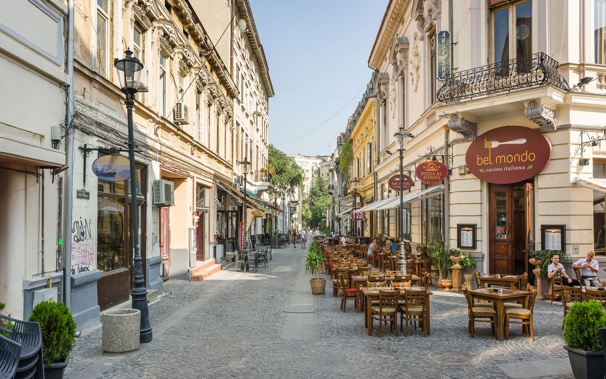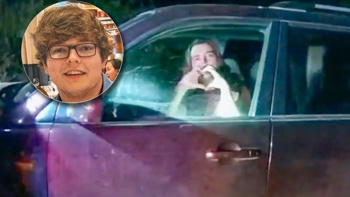
My effervescent Uber driver at Bucharest airport, Mihai, heralded my first foray to Romania with an enthusiastic introductory to his homeland with a few home-truths, as he whisked me to my hotel. “Pork is our favourite vegetable,” he wryly imparted. “Visiting in summer? You will not find sweeter watermelons.” As it was, I was visiting at the start of summer and as I duly discovered, the watermelons were sinfully sweet. Mihai also was keen to impress upon the distinct character of the city’s parks. “Even our smaller parks, our pocket parks are thickly wooded with tall trees. We like to feel as if we are in the forest.” He was right. Bucharest’s tall-timbered parks are very woodsy, accentuating their escapist allure from the urban hustle.
But as Mihai muttered about the selfish, speed-freak nature of Bucharest’s reckless motorists, he philosophically remarked that Romanians are having “the time of their lives. It’s the best time to be a Romanian, with no imperial powers or power-hungry dictators bossing us around.” Like much of the beguiling Balkans, Romania has been a punching bag for empires over the ages, and a tractor-beam for totalitarian rule. They were constant refrains that transcended my riveting two-week romp across the region on Trafalgar Tours’ Balkan Adventure.
We delved into the city’s tumultuous history, by venturing to many of the landmark sites that were intimately linked with Nicolae Ceausescu’s infamous grip on Romania, in the aftermath of World War II. For starters, we basked in Bucharest's sophisticated past, taking a stroll along Victory Avenue, flanked in grand belle époque architecture that has now been scrubbed of its communist-era grime. Pausing by the horseback statue of King Carol I, it proudly stands directly across the street from the old Royal Palace.
Under King Carol, Bucharest flourished in the 1890s and early 20th century. He imported French architects to give Bucharest the romantic elegance that this flamboyant avenue exudes. Nearby, the gorgeous Romanian Athenaeum concert hall and Arch of Triumph (modelled on the Paris landmark), a WWI memorial monument, accentuate the Belle Epoque character. In the concert hall itself, an intricate 70-metre-long and three-metre-high fresco depicting Romania’s history will compete with the philharmonic’s performance for your attention. During the Communist era, which saw the end of the Romanian monarchy, the statue of Carol was replaced by one of Lenin.
 Photo / Supplied
Photo / Supplied
Right next door, we gazed across the austere building façade and balcony of the former Romanian Communist Party headquarters. This was where Ceausescu delivered his final speech as the national uprising intensified in 1989, prior to him fleeing with his wife Elena by helicopter from the building, as crowds stormed party headquarters. Four days later, after a summary trial, they were executed by firing squad. The weird looking statue out front, that looks like an impaled potato, is the Rebirth Memorial in Revolution Square where the revolt took place.
Next up, we ventured to the vanity project to beat them all. Grotesquely extravagant and gigantic in scale, the Palace of the Parliament is Bucharest’s top-billing attraction. The dimensions are jaw-dropping. 12 stories high, 270 metres long and 245 metres wide; 48 metres is visible above the ground and 15 metres is buried below. When Ceausescu ordered the construction of this outlandishly luxurious monstrosity, housing more than a thousand rooms, a vast tract of Bucharest, 20% of the city centre, was clear-felled to make way.
 Photo / Mike Yardley
Photo / Mike Yardley
In the early 1980s, after an "inspiring" visit to North Korea, Ceaușescu set his mind on creating his vain-glorious Civic Centre district, straight out of the Pyongyang playbook, with wide boulevards and colossal stone-faced buildings. 30,000 houses, schools and churches were bulldozed in the process, although urban planners managed to save a few churches by secretly relocating them inside city blocks. Rows of fountains lead from Unity Square to the palace — the largest building in Europe and second largest administrative building in the world, beaten only by the Pentagon.
The design and construction of the building involved 700 architects and 20,000 workers. Only Romanian materials were allowed to be used, including a million cubic metres of marble, 3,500 tonnes of crystal, 700,000 tonnes of steel and bronze, 900,000 cubic metres of wood and 200,000 square metres of carpeting. The result is a giant that is a match for the pyramids of Giza in terms of volume. According to the Guinness Book of World Records, the palace is not only the heaviest, but also the most expensive building in the world, costing NZ$8 billion. My guide quipped, “this is the building that bankrupted a nation. That’s why they were shot.” After literally starving his people to build his dream, the building finally opened in 1994 — five years after Nicolae and Elena Ceaușescu were executed.
The small section open to the public alone is lavishly furnished. Giant crystal chandeliers, mosaics and gold leaf glitter from every angle – silver and gold have even been embroidered into the curtains. Today it’s home to the Romanian Parliament, three mediocre museums, and a conference centre. 70% of its space is still vacant! This Stalinist wedding cake has courted plenty of celebrities. Michael Jackson concluded a press conference here with a moonwalk, after which he appeared on the balcony and shouted “I love you, Budapest” to bemused fans. Shakira has also belted out songs in here and the team from ‘Top Gear’ raced through the basement tunnels to demonstrate how immense this building really is.
 Photo / Supplied
Photo / Supplied
You can also take a tour of the opulent Ceausescu Mansion, also known as the Spring Palace, where the Ceausescus lived in relative luxury until their demise. There’s an opulent marble staircase, a glossy bar, a private movie theatre and a huge walk-in closet which still displays their seriously-retro designer clothing. Check out the private spa’s slimming machines and the lavish mosaics surrounding the indoor swimming pool where the Ceausescu’s’ would take laps while the nation struggled to survive on rationed food and fuel. My guide remarked that the dictator would routinely be driven to work with two rottweiler guard dogs at his side.
I was eager to explore Lipscani, Bucharest's Old Town, or what is left of it, after surviving the communist period. This area, just across the neglected little Dâmbovița River which is wrapped in brutalist apartment blocks, is a revelation. No other neighbourhood in Bucharest has undergone as much change in recent decades quite like Lipscani, the “Little Paris” of the East. Devolved into serious disrepair during the Communist age, Little Paris withered away as building owners had their properties seized by the state.
 Photo / Supplied
Photo / Supplied
Today, the neighbourhood is the vibrant centre of the Romanian art scene and buzzing nightlife destination as the renaissance continues. It’s a slow renaissance because the state is still returning dishevelled buildings back to their private owners, who face enormous renovation costs to restore them to their former glory. For centuries, Lipscani was the vibrant trading centre of the city. The names of the streets still refer to the different guilds that plied their trade here: goldsmiths, shoemakers and tanners.
Grand, glittering buildings, from churches and theatres to bank headquarters have been scrubbed and polished. Formerly abandoned shopping galleries are sparkling and inviting. Historical monuments — like the splendid Hanul lui Manuc, an early-19th-century inn — have been meticulously restored. As has the treasured 18th century Stavropoleos Church, built in the unique Romanian architectural style known as Brancoveanu. It features an intricately carved and columned entrance. Fine stone and wood carvings and a combination of Romanian and Byzantine elements can be admired in the Greek Orthodox church’s interior. Check out the radiantly restored 19th century Carturesti Carusel. It’s one of the most beautiful bookstores in Europe with light filtering through a central skylight making the space seem like visitors are in a moving carousel.
 Photo / Supplied
Photo / Supplied
An al fresco dining and drinking scene enlivens the traffic-free cobbled streets that are a thrill to stroll. The lanes of the Old Town lustily transform after dark (especially on weekends), when the entire neighbourhood morphs into one big, sprawling, bar-hopping cocktail party. It is one of Eastern Europe’s buzziest nightlife precincts with an infectious party vibe. Gorgeous old art nouveau buildings have been transformed into hospitality precincts, too.
Traditional Romanian cuisine is not exactly show-stopping, unless you enjoy stuffing yourself stupid on pork, tripe soup (great hangover remedy) and polenta soup. There were two culinary signatures that stood-out. Transylvanian goulash, which simmers for eight hours in a wood-fired oven, is hearty and flavourful with boneless pork, green peppers, sour cream and sauerkraut. For a sweet treat, tuck into papanași, one of the great Romanian desserts: a doughnut filled with sweet fresh cheese (similar to ricotta) and topped with sour cream and jam.
And be sure to try a shot or two of Romanian Tuica, a traditional fruit spirit made only from plums. There’s a strong Italian influence to the restaurant scene, so great pasta is never far away. Interestingly, the Romanian language and Italian both use the Latin alphabet, unlike much of the Balkans. One of the best places to feast in Bucharest is at the grand old restaurant, Caru cu Bere. This gothic arched, wood-panelled institution with over a 130 years old under its belt is the go-to for visiting celebrities. Bucharest has a thriving craft beer scene, if you need a break from the palinka. Be sure to order Caru cu Bere’s in-house beer, made from a unique recipe from 1879! I’ll drink to that.
Trafalgar’s amazing Balkan Adventure is a 14 day tour, spanning seven countries and 13 cities. Enjoy excellent four-star accommodations, extensive sightseeing, outstanding specialist local guides, super-comfy coach travel with on-board Wi-Fi, plus most meals are included. It’s a hassle-free way to explore this eye-opening part of the world. For 2024 tour dates, prices start from $5,895 per person, twin share. www.trafalgar.com/en-nz/tours/balkan-adventure
Mike Yardley is our resident traveller on Jack Tame Saturday Mornings.
Take your Radio, Podcasts and Music with you









